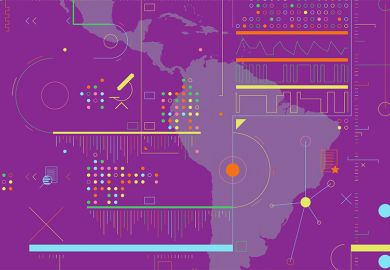Browse the full results of the Latin America University Rankings 2017
Before the explosion of ubiquitous technology, when information was available only from textbooks and scholars, and when a degree lasted a lifetime, going to university to acquire information and to prepare for a traditional profession made sense. The objectives and activities that define undergraduate education are now being reconsidered in much of the world, but perhaps less so in Latin America.
The problem begins with the lack of orientation provided to prospective students throughout the region. Few adolescents can name more than a handful of career options – doctor, engineer, lawyer, veterinarian, economist, psychologist and perhaps a few others. Career orientation is limited if it exists at all. Yet we are living in a world where new career paths are appearing at near breakneck speed. Who could have imagined the high demand for experts in cybersecurity a short time ago?
In nearly all universities in Latin America today, a 17- or 18-year-old must commit to a career path, then sit through five or six years of lectures and examinations to gain a university degree. For students who find that they didn’t fully understand the requirements of the degree they’ve undertaken, or who find themselves underprepared, or who discover that their aptitudes lie in a different direction, the options are limited – forge ahead with the original choice, drop out or start over from the beginning in another programme. Courses of study tend to be overloaded with content and rigid to the point that it is near impossible to obtain credit for prior study from another degree programme, let alone another university.
The rigidity of degree programmes is extremely problematic. We live in an interdisciplinary world, but few degree programmes in Latin America allow for interdisciplinary learning. One needs only to consider the confluence of biology, medicine and engineering that led to the creation of the field of biomedical engineering a few decades ago. Yet few universities in the region allow for the flexibility that would allow students to combine study from different programmes to enhance personal and intellectual development more fully, and even less likely in a way that might lead to new fields of study.
Interdisciplinarity encourages the development of creative and innovative thinking, an outcome eagerly sought by the job market, fundamental to global competitiveness and often critical for groundbreaking research. Steve Jobs, perhaps one of the best-known advocates of integrating liberal arts with technology and liberal arts with science, recognised that the creativity that comes from participating in the arts and humanities adds enormous value to study in the sciences, technology, engineering and mathematics fields. Latin America must make room in the university curriculum for imaginative (and individual) combinations of fields of study.
Download a copy of the Latin America University Rankings 2017 digital supplement
The classroom dynamic has to change as well. The continued reliance on lectures as the primary interaction between academic and student limits the skills and capacities that university students develop. The transmission of information to students passively taking notes (or sending text messages to friends when they lose interest in the lecture) may provide students with a good base of theoretical knowledge but it offers little practice in the application of knowledge or in applying knowledge creatively to real-world problems.
There is growing awareness worldwide that the model of higher education employed since the founding of the University of Bologna may have run its course. The pace of change has been slow everywhere, but with a few notable exceptions, Latin America has been particularly slow to join the global discussion of new strategies for active learning, hybrid learning, competency-based learning, peer instruction and more. Reform in the region is slowed further by the limited resources allocated to the training of and support for professors to help them adapt to new models for teaching and learning.
And then there are the structural obstacles. Universities are limited by degree recognition and accreditation processes that are firmly entrenched in the past and often act as checklists that force conformity.
Tradition is a powerful force that can impede change, yet change is needed if Latin America is going to be competitive in a world where rapid innovation continually creates new social, economic and technical realities. The design of undergraduate education in Latin America must change. Although a few universities in the region are experimenting with innovation, most remain locked into tradition. The question now is whether change will come from above, from below or not at all.
Liz Reisberg, international higher education consultant.
Register to continue
Why register?
- Registration is free and only takes a moment
- Once registered, you can read 3 articles a month
- Sign up for our newsletter
Subscribe
Or subscribe for unlimited access to:
- Unlimited access to news, views, insights & reviews
- Digital editions
- Digital access to THE’s university and college rankings analysis
Already registered or a current subscriber?








